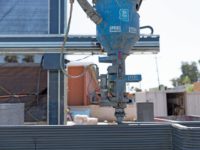The life-cycle papers attempt to quantify how buildings and pavements contribute to U.S. global warming. But carbon is not the only factor. "If you are using concrete in a building or a pavement, we're analyzing the cost from a CO² perspective, an energy perspective and a dollar perspective," says Jennings. "All those things are what we mean by sustainability."
The Hub's latest research centers around changing cement's properties. In 2009, Roland Pellenq, a physicist and materials scientist who works at MIT and the French government's National Center of Scientific Research at Marseille University, developed what scientists believe is the first atomic model of portland cement. This, he says, is the key to making concrete a 21st-century material.
"The science of concrete has been sleeping for a long, long time," says Pellenq, who likens his work to how today's pharmaceuticals are made. Instead of conducting lab experiments first, scientists screen molecular possibilities on a computer, or "in silico." Pellenq says, "If you can master the chemistry, you are also mastering the mechanical properties."




